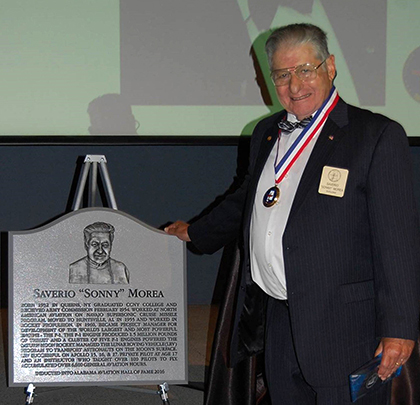Alabama honors famous pilots
Three pilots who grew up in the same Alabama town but followed different paths to becoming star performers on the airshow circuit will have a homecoming of sorts next spring when they are inducted into the Alabama Aviation Hall of Fame.
When they do, they will become members of an elite group that also includes a more than 50-year AOPA member whose aerospace accomplishments include propelling astronauts to the moon and giving them a way to get around on the surface, as well as teaching more than 100 people how to fly airplanes here above the earth.
Koontz’s flying continues in the flying circus tradition whether he is performing a routine in his Super Decathlon, or playing the role of farmer Clem Cleaver, who “steals” a Piper Cub and after a cops-and-robbers-style chase from the Alabama Boys, lands it on a moving pickup truck.
A memory from his childhood days in the Birmingham suburb of Cahaba Heights is that of being friends, and in the Boy Scouts, with “two little twins” from an aviation family.
The twins were Alan and Mark Henley, whose father collected classic airplanes, which provided his sons the chance to become pilots at an early age at the controls of the family’s Cessna 140 and a Piper J-3 Cub.

After becoming a pilot, Alan quickly moved on to aerobatic flying in a Stearman, and then in a North American AT-6. He met aerobatic and formation-flight specialist Steve Gustafson at an airshow, and the pair teamed up to form an act that over more than 25 years would evolve from a casual weekend sideline to the famed precision-flight Aeroshell Aerobatic Team.
Taking the act full-time had not been his goal, Alan said, but push came to shove because airshows and his main occupation—the cattle business—both get busy at the same time of year.
“It got to be a struggle,” he said in a telephone interview. “It finally got to point where I had to make a decision to do one or the other.”
Airshows, he recalled, were then “starting to be a lot more lucrative than the farming.” He made the switch to flying full-time, and, “I never looked back.”
Alan’s brother Mark was equally influenced by the family immersion in aviation, and after performing in Stearmans, the AT-6, and the North American P-51D Mustang, he joined the Aeroshell Aerobatic Team, becoming the team lead.
Mark said he was surprised to learn that he, Alan, and Koontz, were headed for the Hall of Fame—an institution he surmised was more typically populated by “ex-war heroes” and other aviation luminaries.
“We do what we like doing. We don’t think about being famous,” he said.

Doing what he likes doing kept Mark and the Aeroshell Aerobatic Team busy in 2017, flying dates from El Salvador to New Jersey, and putting more time on the aircraft than had been the case in recent years. (Alan suffered a severe neck injury in a home accident in 2008, and is not able to fly.)
The end of the year’s flying season doesn’t suggest that Mark—who like his brother is an airframe and powerplant mechanic, among their many aviation credentials and ratings—plans to relax.
“When I stop flying airshows I start turning wrenches,” Mark said.
The formal induction ceremony in the Alabama Aviation Hall of Fame, which is hosted by the Southern Museum of Flight in Birmingham, is expected to take place in spring 2018.
‘It’s not a buggy’
When the induction occurs, Koontz and the Henleys will join the ranks of aviation history-makers including an AOPA member whose work helped propel Saturn rockets to the moon, and then provided their occupants with a way to navigate the lunar surface.
In 2016, Saverio “Sonny” Morea, a New York City-born scientist and pilot who moved to Huntsville, Alabama, in 1955, and managed the project that developed the Saturn moon rocket, and later, the Lunar Roving Vehicle Program, entered the Alabama Aviation Hall of Fame.
His induction announcement also noted that Morea, who had become a private pilot at 17, had gone on to become a flight instructor who taught more than 100 student pilots to fly over 3,000 hours of instructing.

For 30 years Morea owned a Cessna 210 and “flew it all over the country,” he said, adding that at age 85 he had not flown for several years.
It’s not usually rocket science to chronicle how a member of the aviation community earns a berth in a hall of fame—but in the case of Morea, whose work on the space programs was under the supervision of Wernher von Braun, known as the father of space science in the United States, that rule obviously doesn’t apply.
Still, when Morea recounts his experience as a maker of scientific history, he does so with a light touch, recalling that while getting an astronaut to the moon was within his known capabilities, helping the lunar visitors get around on the surface was another matter.
“I don’t know anything about cars, and I sure don’t know anything about them on the moon,” he said in a dismissive response to a request from his bosses to take on the LRV project.
Like it or not, Morea was about to take a giant leap into surface-vehicle engineering.
“The next morning the guy calls back. ‘Von Braun says if you can manage the development of the F1 engine—one billion dollars—surely you should be able to manage this smaller program, $40 million and 17 months,’” Morea recalled.
That settled that, and the rest, as they say, is history.
With one caveat: If you want to get on Morea’s bad side, go ahead and use a historically inaccurate pop term to describe the product of Morea’s LRV project.
“I get offended today because most people refer to it as the moon buggy,” he said. “It’s not a buggy.”
What should one call it?
"Pretty simple," he replied. "A spacecraft on wheels."




